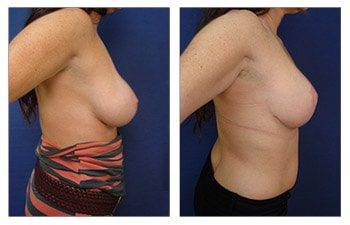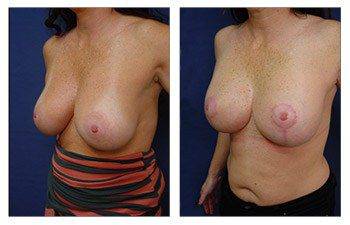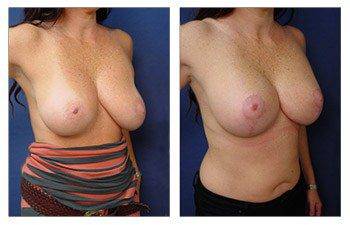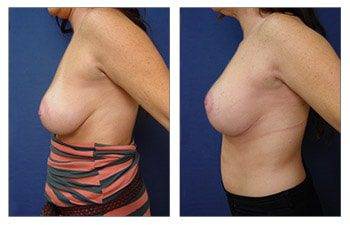





Breast augmentation revision surgery recovery is more involved than breast primary breast augmentation because of two major aspects.
a) The first principle is a capsule alteration for implant pocket manipulation which is required to heal the new capsule. The capsule is used as a guard that holds the new implant pocket position. It can be incised by a capsulotomy, cut out by a procedure called a capsulectomy, or even sewn back together or sometimes tightened, which is a procedure called capsulorrhaphy. A capsule alteration by sewing the implant pocket, or the capsule, back together, for example, is popular when getting a breast lateralization
Breast lateralization is when the implants fall into the armpits. Breast lateralization will actually maintain the capsule and allow a surgeon to sew the capsule tight to eliminate the lateral open space. This would simultaneously open up the medial capsule to allow for readjustment of the pocket position from lateral to medial. This capsule then needs time to heal, approximately 4 weeks, so recovery for a breast augmentation revision is prolonged versus a breast augmentation. As far as recovery and your activity, you can go back to working out your lower body at 2 weeks for a breast augmentation revision versus 4 weeks for a breast augmentation. We don’t want you jumping as that risks the ripping of the capsule.
b) The second principle for a breast augmentation revision is the breast lift. It is common for a Breast Augmentation Revision to need a breast lift. A breast lift entails longer incision lines than just a breast augmentation, which also means that you cannot sweat for 4 weeks, versus the two weeks a breast augmentation would require. The incision line healing is critical not only because of the longer lines but also due to the cut around the nipple and areola being more visible. We must optimize incision line healing more so with a breast augmentation revision.
Plastic Surgeons who specialize in this surgical procedure must be experienced not only in breast augmentation surgery as well as breast implant revision surgery. Often surgeons must address changing of current implants as well as accommodate breast tissues such as scar tissue. Choosing amongst implant types requires considering silicone implants vs saline implants as well as considerations of intrinsic patient criteria such as weight fluctuations like weight gain or loss.
Introduction: Navigating the Road to Recovery: Breast Augmentation Revision Surgery
Recovery from breast augmentation revision surgery is a crucial phase in the overall process of enhancing breast aesthetics and addressing complications or concerns from previous surgeries. This essay explores the intricate journey of postoperative recovery, offering insights into the timeline, patient experiences, and the critical role that aftercare and self-care play in achieving a successful outcome.
Understanding the Need for Breast Augmentation Revision Surgery
Before delving into the recovery process, it is essential to understand why breast augmentation revision surgery is necessary. Several reasons prompt patients to seek revision:
- Complications: Complications such as implant malposition, capsular contracture, implant rupture, and asymmetry may necessitate revision surgery.
- Changing Aesthetic Preferences: Patients’ aesthetic preferences may evolve over time, leading to a desire for adjustments in implant size, shape, or type.
- Natural Aging: As patients age, changes in breast appearance and skin elasticity can impact the results of their initial augmentation.
- Motherhood and Pregnancy: Women who have experienced pregnancy and breastfeeding may notice changes in breast size and shape, requiring revision procedures.
- Enhancement and Symmetry: Some patients opt for breast augmentation revision to enhance their initial results or address issues like breast size asymmetry.
Recovery Timeline
- Immediate Postoperative Period (Day 0 to Day 1):
- Patients are closely monitored in the recovery room immediately after surgery.
- They may experience grogginess, pain, and mild discomfort.
- Swelling and bruising are common, and the breasts may be tightly wrapped in a surgical garment or compression bra.
- Surgical dressings and drains, if used, are typically checked by the surgical team.
- The patient is usually released on the same day with a responsible adult for transportation and care at home.
2. First Few Days (Day 1 to Day 3):
- Patients may experience postoperative pain, swelling, and discomfort.
- Prescription pain medications and antibiotics are often prescribed to manage pain and prevent infection.
- Activity and mobility are limited, and patients are encouraged to rest and avoid strenuous physical activities.
- Close monitoring of surgical sites is essential to detect any signs of infection or complications.
3. First Week (Day 3 to Day 7):
- Swelling and bruising begin to subside, and discomfort typically diminishes.
- Most patients can start gentle activities like walking but should avoid strenuous exercises.
- Sutures may be removed during this period.
- Patients must adhere to the surgeon’s specific postoperative care instructions regarding medication, compression garments, and incision site care.
4. Weeks 2 to 6:
- The majority of swelling and bruising have significantly decreased.
- Patients can gradually resume more regular daily activities.
- Some residual swelling may persist, and patients should continue to wear the recommended compression garments.
- It is advisable to avoid heavy lifting and strenuous exercise, as well as activities that could put pressure on the surgical sites.
5. Weeks 6 and Beyond:
- By this stage, most patients have returned to their normal daily routines.
- Swelling should be minimal, and the breasts will begin to settle into their final shape.
- Patients can usually start engaging in more strenuous physical activities, although it is essential to consult with the surgeon for approval.
- Follow-up appointments with the surgeon are important to monitor progress and ensure the best possible outcome.
Patient Experience During Recovery
- Pain Management: Discomfort and pain are common in the immediate postoperative period, and patients are typically prescribed pain medications. Over time, pain diminishes, but it is essential to adhere to the prescribed pain management plan to stay comfortable.
- Swelling and Bruising: Swelling and bruising are common side effects following breast augmentation revision. These gradually subside over the recovery period, with patients seeing significant improvement within the first few weeks.
- Compression Garments and Dressings: Patients are often required to wear compression garments or surgical bras during the early recovery phase. These garments help reduce swelling, provide support, and protect the surgical sites.
- Limited Mobility: Initially, patients experience limited mobility and should avoid heavy lifting or strenuous activities. It is crucial to follow the surgeon’s recommendations to prevent complications or potential damage to the surgical sites.
- Emotional Rollercoaster: Recovery can be an emotional rollercoaster for some patients. It is normal to have mixed feelings, including anxiety, excitement, and impatience. Emotional support from friends, family, or support groups can be valuable during this time.
- Follow-Up Appointments: Regular follow-up appointments with the surgeon are essential for monitoring progress, addressing any concerns, and ensuring that the breasts heal and settle properly.
Postoperative Care and Self-Care
- Medication: Patients should diligently follow the prescribed medication regimen. Pain medications and antibiotics are typically prescribed to manage discomfort and prevent infections.
- Rest and Recovery: Adequate rest and relaxation are vital for the healing process. Patients should avoid strenuous physical activities and get plenty of sleep.
- Scar Care: Proper care of surgical incisions is crucial for minimizing scarring. Surgeons provide instructions for cleaning, moisturizing, and protecting the incisions from sun exposure.
- Compression Garments: Patients must continue wearing compression garments or surgical bras as recommended by the surgeon to control swelling and support the healing process.
- Diet and Hydration: A balanced diet and proper hydration promote healing and reduce the risk of complications. Nutrient-rich foods support tissue repair.
- Emotional Support: Emotional well-being is just as important as physical recovery. Patients may experience mood swings, anxiety, or depression during recovery. Seeking emotional support from friends, family, or support groups can help.
- Follow-Up Care: Attending all scheduled follow-up appointments is crucial for monitoring progress and addressing any issues promptly. Surgeons can provide guidance on the next steps in the recovery process.
Potential Complications and When to Seek Help
While most patients experience a relatively smooth recovery, it is important to be aware of potential complications. Patients should promptly seek medical attention if they experience:
- Fever or chills, which may indicate infection.
- Increased or severe pain that is not alleviated by prescribed medications.
- Excessive bleeding or drainage from the incision sites.
- Signs of implant-related complications, such as implant malposition, rupture, or capsular contracture.
- Worsening or persistent swelling, bruising, or redness at the surgical sites.
- Any changes in breast appearance or unusual sensations that cause concern.
Conclusion: Breast Augmentation Revision Surgery
Recovery from breast augmentation revision surgery is a multi-faceted journey that requires patience, self-care, and adherence to postoperative guidelines. It is a process that involves discomfort, swelling, and emotional ups and downs. However, with the support of a skilled surgical team and a robust recovery plan, patients can achieve their desired outcomes and enjoy the aesthetic and emotional benefits of breast revision surgery. Understanding the recovery timeline, embracing self-care, and promptly addressing any concerns or complications are key factors in ensuring a successful and satisfying recovery experience.
